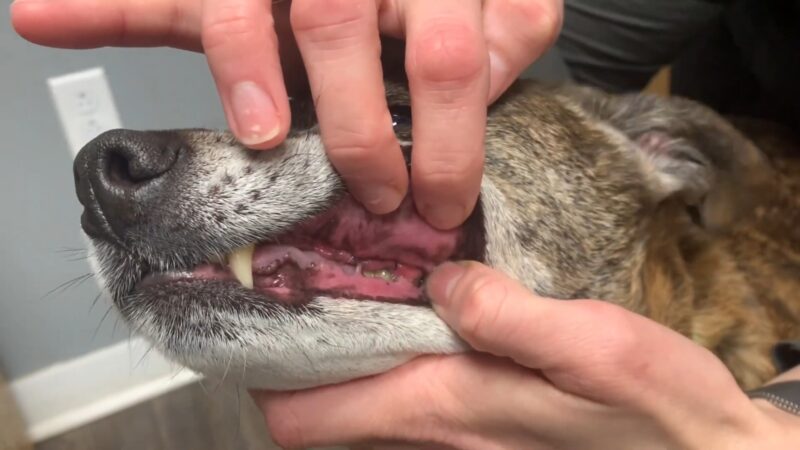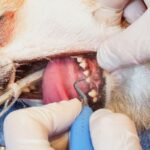A dog tooth abscess is a painful condition that occurs when a bacterial infection invades the tissue below a broken tooth. It can cause serious complications if left untreated, such as bone loss, eye damage, or sepsis.
In this post, we will discuss the signs, causes, treatment, and prevention of a dog tooth abscess, and how to care for your dog after surgery.
Signs of Abscess

A dog tooth abscess may not be obvious at first, as dogs tend to hide their pain and discomfort. However, there are some signs that you can look for to detect a possible tooth abscess, such as:
- Bad breath (halitosis): This is one of the most common signs of a dental infection, as the bacteria produce foul-smelling gases and toxins.
- Blood on toys: If your dog has a broken tooth, you may notice blood on their toys, especially if they are hard or abrasive.
- Under-eye “pimple” or swelling: A tooth abscess can cause swelling and inflammation in the surrounding tissues, which may appear as a bump or a pimple under the eye. This is more common for abscesses in the upper teeth.
- Redness and swelling of the gums: The gums may become red, swollen, and tender to the touch, indicating infection and inflammation.
- Pawing at the face: Your dog may paw at their face or rub it against objects to relieve the pain or itchiness caused by the abscess.
- Dragging or pushing one side of the face into the furniture: Your dog may also try to apply pressure to the affected area by dragging or pushing their face into the furniture or the floor.
- Fever: A tooth abscess can cause a systemic infection, which may result in a fever and lethargy.
- Behavioral changes: The pain and discomfort your dog experiences might lead to noticeable changes in their behavior. They could become more irritable or aggressive, or even start to withdraw from usual activities. You might also notice an increase in barking, a sign of their distress.
If you notice any of these signs, you should take your dog to the veterinarian as soon as possible for a proper diagnosis and treatment.
Causes of a Dog Tooth Abscess
A dog tooth abscess is usually caused by a bacterial infection that enters the tooth through a crack, fracture, or cavity. The bacteria then multiply and form a pus-filled pocket under the tooth, which puts pressure on the nerve and blood vessels.
The most common bacteria involved in a dog tooth abscess are Streptococcus, Staphylococcus, and Actinomyces.
Risk Factors

Poor dental hygiene, such as not regularly brushing your dog’s teeth or providing dental chews and toys, can lead to plaque and tartar buildup. This creates an ideal environment for bacteria to thrive.
Additionally, trauma or injury from chewing hard objects like bones, rocks, or sticks can damage their teeth, allowing bacteria to enter. Dogs with periodontal disease, and chronic inflammation of the gums and tooth-supporting structures, face a higher risk of tooth loss, bone erosion, and weakened immunity, making them more susceptible to infections.
Age and Breed

Age is also a factor; older dogs tend to develop tooth abscesses more frequently as their teeth and gums deteriorate over time. Furthermore, certain breeds, particularly brachycephalic breeds like pugs, bulldogs, or boxers, with their crowded teeth and limited mouth space, are more vulnerable to dental issues.
Medical Treatment
The treatment of a dog tooth abscess depends on the severity and location of the infection, as well as the overall health of your dog. The main goals of the treatment are to eliminate the infection, relieve the pain, and preserve the tooth if possible.
The treatment options include:
- Antibiotics, painkillers, and anti-inflammatories: These medications are usually prescribed to manage the infection and the pain, and to reduce the swelling and inflammation. They are usually given orally, but in some cases, they may be injected directly into the abscess or the surrounding tissues.
- Endodontic (Root Canal Therapy): This is a procedure that involves removing the infected pulp (the soft tissue inside the tooth) and filling the root canal with a sterile material. This can save the tooth and prevent further infection, but it may require multiple visits and anesthesia.
- Extraction: This is the removal of the affected tooth, which is usually done under general anesthesia. This can be the simplest and most effective way to treat a tooth abscess, but it may also have some drawbacks, such as affecting the bite, the appearance, or the chewing ability of your dog.
- Post-operative antibiotics: After the surgery, your dog may need to take antibiotics for a few days or weeks to prevent any secondary infections or complications.
Get Ahead with Periodic Dental Cleaning

One of the best ways to prevent a dog tooth abscess is to maintain good dental hygiene for your dog.
Cost of professional help
You should take your dog to the veterinarian for a professional dental cleaning at least once a year, or more often if recommended by your vet. This can help remove any plaque and tartar that may harbor bacteria, and also detect any signs of dental disease or damage.
The cost of a professional dental cleaning may vary depending on the location, the clinic, and the condition of your dog’s teeth, but it is usually worth the investment, as it can save you from more expensive and complicated treatments later on.
Importance of regular dental check-ups
Regular dental check-ups at the vet are crucial for your dog, particularly if you notice changes in their behavior, eating habits, or oral health. These visits allow for early detection and treatment of dental issues, preventing them from becoming more severe or painful.
Tips for dental care
At home, it’s important to maintain your dog’s dental health. Provide them with safe chew toys, like rubber or nylon, which aid in cleaning their teeth and massaging their gums.
Avoid bones, antlers, or hooves, as these can break and harm their teeth or gums. Regularly brushing your dog’s teeth with a soft-bristled brush and dog-specific toothpaste can prevent plaque and tartar buildup, keeping their breath fresh.
At Home Post-Surgical Care
After your dog’s tooth abscess surgery, certain steps are essential for a smooth recovery.
Soft Food Diet
Post-surgery, your dog might need soft or moist food for a few days or weeks, based on the surgery type and healing. Avoid giving them dry, hard, or crunchy food to prevent irritation or injury to the wound or stitches.
Ensure they have access to fresh water and keep an eye on their food and water consumption.
Serious AfterCare for a Complicated Extraction
For complex extractions, like removing a multi-rooted tooth or a large abscess, your dog may require more thorough aftercare, including antibiotics, pain relief, anti-inflammatory medication, or possibly a drain or bandage. Follow your vet’s advice closely and regularly inspect the wound for signs of infection, bleeding, or swelling.
Keep your dog isolated from other pets to prevent them from licking or biting the wound.
Pain Management
Post-operative pain and discomfort are common, particularly in the initial days. Administer any prescribed painkillers and anti-inflammatories, and avoid disturbing the affected area.
Provide a calm, comfortable space for your dog to rest and recuperate, steering clear of vigorous or stressful activities like running or playing.
FAQ
Can a dog tooth abscess heal on its own?
No, a dog tooth abscess won’t heal on its own and requires veterinary treatment to prevent serious complications.
What can I feed my dog after tooth abscess surgery?
After surgery, it’s best to feed your dog soft or moist food to avoid putting pressure on the healing area.
How can I tell if my dog’s tooth abscess is getting worse?
Worsening symptoms like increased swelling, persistent pain, or signs of infection indicate that the abscess is getting worse and needs immediate veterinary attention.
Is bad breath always a sign of a tooth abscess in dogs?
While bad breath can be a sign of a tooth abscess, it’s not always conclusive and can be caused by other dental issues.
How often should I brush my dog’s teeth to prevent abscesses?
Regular brushing, ideally daily, is recommended to prevent dental issues like abscesses in dogs.
Can a tooth abscess affect my dog’s overall health?
Yes, an untreated tooth abscess can lead to systemic infections and impact your dog’s overall health, including potential bone loss and eye damage.
Final Words
Dental disease in dogs is a serious issue, and prevention through regular professional dental check-ups and proper dental care is essential. A dog tooth abscess is a painful and potentially dangerous condition, that requires immediate veterinary attention and treatment.
By following the tips and advice in this post, you can help your dog avoid a tooth abscess, or manage it effectively if it occurs. Remember, a healthy mouth means a happy dog!







